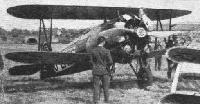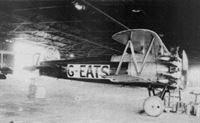
Описание
Страна : Великобритания
Год : 1919
Единственный экземпляр
Flight, December 1919
THE PARIS AERO SHOW 1919
PRELIMINARY REPORT ON BRITISH SECTION
The British and Colonial Aeroplane Co., Ltd.
The Bristol "Bullet"
As the name indicates, this machine is one designed for high-speed racing. Its general appearance is indicated in the accompanying silhouette. Fitted with a nine-cylindered radial air-cooled Cosmos "Jupiter" engine, this machine is capable of a maximum speed of 160 m.p.h. As a racer, therefore, the "Bullet" should give a good account of itself in the events of the coming year. A feature - one might say the feature - of this machine, which is not apparent on a casual examination, is the exceptional strength of the wing structure. This is attained, chiefly, by the novel design of the wing spars, which are in duplicate. In this manner, while adhering to the employment of aerofoils of the usual section, extraordinarily high spar strength is maintained, and we understand that in the case of the "Bullet" the spars are so strong that any evolution of which the machine is capable may be carried out with perfect safety at the maximum speed of 160 m.p.h. As a racer and "stunt" machine the "Bullet" will probably be much in evidence during 1920. Considering the high maximum speed - 160 m.p.h. - the landing speed is reasonably low, i,e,. 50 m.p.h. The machine has an overall length of 24 ft. 1 in. and a span of 31 ft. 2 1/2 ins. The petrol tank has a capacity of 50 gallons.
Описание:
- Flight, December 1919
THE PARIS AERO SHOW 1919 - Flight, January 1920
The Paris Aero Show 1919
Фотографии
-
Flight 1920-07 / Flight
Регистрационный номер: G-EATS [8] The Bristol "Bullet," 450 h.p. Bristol "Jupiter " (No. 14), piloted by Mr. Uwins in the Aerial Derby
-
Flight 1920-02 / Flight
Регистрационный номер: G-EATS [8] The 450 h.p. Cosmos "Jupiter" fitted in the Bristol Bullet
-
Flight 1922-08 / Flight
Регистрационный номер: G-EATS [8] THE AERIAL DERBY: Bristol "Bullet," 400 h.p. Bristol "Jupiter."
-
Flight 1939-03 / Flight
Регистрационный номер: G-EATS [8] The Bullet, type 32. This machine was fitted with the first Jupiter engine built by the Bristol company. It was raced in the King's Cup and Aerial Derby.
-
Flight 1921-07 / Flight
Регистрационный номер: G-EATS [8] THE AERIAL DERBY. Photographs of the starters. 9. Bristol Bullet
-
Aeroplane Monthly 1978-02 / Personal album
Регистрационный номер: G-EATS [8] Bristol Bullet Type 32 G-EATS was built as a flying testbed for the Bristol Jupiter radial engine.
-
Aeroplane Monthly 1982-11 / B.Gunston - The classic aero engines (3)
Регистрационный номер: G-EATS [8] This much-modified Bristol Type 32B Bullet was originally built as a flying test bed for the 450 h.p. Cosmos (later Bristol) Jupiter radial.
-
Flight 1921-12 / Flight
Регистрационный номер: G-EATS [8] Mounting of "Jupiter" engine in Bristol "Bullet" aeroplane.
-
Flight 1919-12 / Flight
The Bristol Racer, 450 h.p. Cosmos "Jupiter"
- Фотографии








